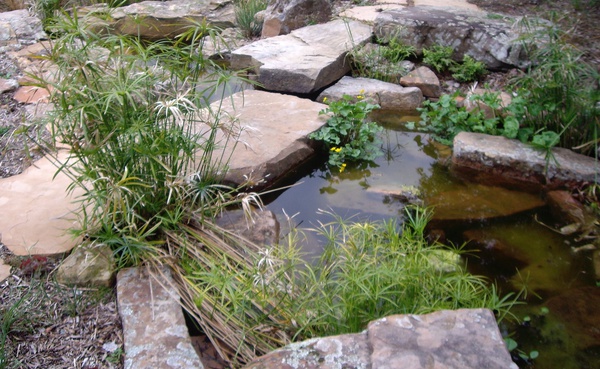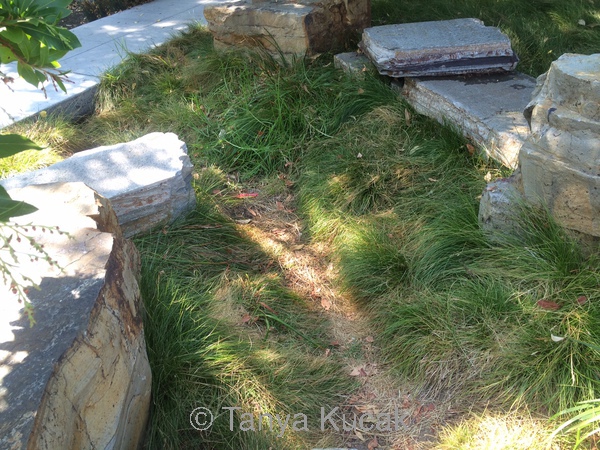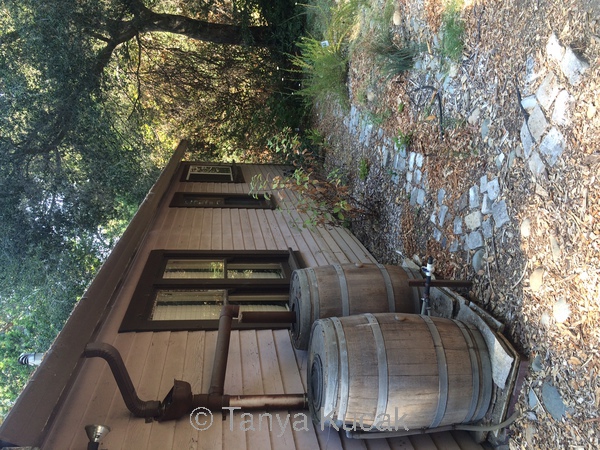
Over 50 years ago, my aunt in New Jersey had a wooden rain barrel under her downspout. When we took a walk in her garden, she'd fill her watering can and water selected plants. It made sense to collect the “free” water that fell on the roof.
Today you can buy a 50-gallon plastic rain barrel for around $75-$200, and some surrounding towns even offer a rebate, but how practical are rain barrels on a small suburban lot in California's summer-dry climate? Ellen Judd considered adding rain storage to her Mountain View garden, but decided she “didn't want to devote a lot of space to a giant tank.” She hired Bay Maples to install lots of low-water plants, which “reduced the urgency” of rainwater harvesting. But she also discovered that the least expensive and most practical way to conserve water is laundry to landscape (L2L), a simple retrofit that diverts washing-machine water directly to fruit trees and shrubs. Unlike seasonal rainwater, greywater (which cannot be stored) offers “a steady trickle of water” year-round.
But what if you did have enough space to collect all the rain that fell on your roof?
At the height of the rainy season, about one-tenth of an inch of rain falls on a typical rainy day in Los Altos. If all that rain fell on a 1000 sq. ft. roof and was collected, it would fill one 60-gallon rain barrel. Multiply that by several rainy days, or a few big rainstorms, and it's easy to see that putting a rain barrel under every downspout would not come close to collecting it all. Historical records show up to 38 inches of rain each season, but a more conservative estimate is about 15 inches, which amounts to 9000 gallons of water a year falling on a 1000 sq. ft. roof.
Does that seem like a lot of water? Unless you've already thought about water conservation, chances are you're using a lot more water than that. You can reduce your water usage considerably by changing your landscape:
With a combination of conservation, lawn reduction, smart design, greywater, and irrigation fine-tuning, Markowitz was able to meet his client's goal with an 86,000 gallon underground tank. Greywater contributes 43,000 gallons, from showers and laundry, which is half of all water used indoors.
A more typical system that stores a significant amount of water with above-ground tanks requires a space at least 8 ft. by 8 ft. “It's not just capturing water,” he said. It's also “designing a smart landscape that looks really good but uses less water.” If you change the plants, “you can have the same composition and colors, and get the same effect,” and use only 20 percent of the water, Markowitz said.
Like any good resource planner, Markowitz begins each project by determining the budget, in this case the water supply, which depends on your roof area and the expected rainfall. Then he designs a landscape to fit that water budget. As with any budget, living within your means entails first looking at ways to reduce your “expenses.”
For the landscape as a whole, “people typically overwater by a factor of 3,” he said. Cutting back on lawns is crucial. “It takes 23,000 gallons of water to keep 1000 sq. ft. of lawn green,” he said. Replacing sprinklers with MP Rotators or drip irrigation can cut water use in half, as can replacing traditional turf with a native-grass blend. Converting all or part of a lawn to a patio, which is likely to get considerably more use and needs no water, is another smart way to stay within a water budget, he said.

Kit Gordon captures rainwater in several barrels for refilling her natural pond in Los Altos Hills. Using rainwater keeps chloramine out of the pond. (Photo: Kit Gordon)

At the Packard Foundation in downtown Los Altos, rainwater flows from the visitor's parking lot and a nearby sidewalk into a catch basin landscaped with rocks and grasses.

At the Redwood Grove demonstration garden, rainwater is collected in repurposed oak wine barrels from Ridge Vineyards. One barrel can collect only enough to water about 2 sq. ft. of lawn each year. The nearby rock-lined swales, planted with native grasses, are an example of an effective way to manage rainwater in most landscapes.

A red Xerxes fiberglass water storage tank can hold enough water for a well-designed, drought-tolerant landscape. A 30 ft. by 10 ft. tank like this was installed under a driveway for rainwater storage at a Los Altos Hills property. (Photo: Bobby Markowitz)
© 2016 Tanya Kucak